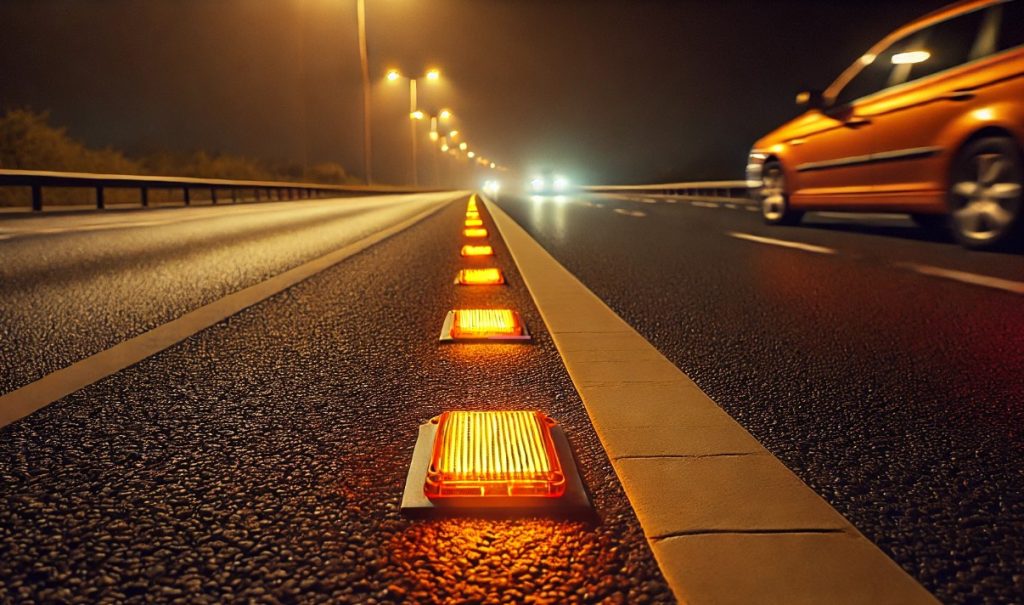Table of Contents
Navigating the UK’s motorway network requires understanding its safety features, with reflective road studs, or cat’s eyes, being vital for guiding drivers, particularly in low visibility.
These studs, found in various colours, help identify specific parts of the road. Amber reflective studs, in particular, play a crucial role in motorway safety. So, where are amber reflective studs found on a motorway?
Positioned between the central reservation and the carriageway, these studs help separate opposing traffic flows and improve visibility in dark or adverse conditions.
This article explores the significance of amber reflective studs, their placement, and their essential role in ensuring safer journeys for all motorists.
What Are Amber Reflective Studs?

Amber reflective studs are safety devices embedded into motorways to guide drivers and improve visibility, particularly in low-light conditions. These studs mark the central reservation, which separates traffic moving in opposite directions on dual carriageways and motorways.
The reflective surface of amber studs is designed to catch and reflect vehicle headlights, providing a clear visual boundary for drivers.
Amber studs serve a critical purpose in maintaining safe driving conditions by preventing lane departures and offering a point of reference during adverse weather.
Unlike standard painted road markings, these studs remain visible even in fog, rain, or darkness. They are made of durable materials to withstand heavy traffic and harsh environmental conditions, ensuring long-lasting functionality.
By clearly indicating the edges of the central reservation, amber studs help drivers stay in their lanes, reducing the likelihood of head-on collisions.
These studs are part of a broader system of reflective markers, each with a specific purpose, that collectively enhance road safety and facilitate smooth traffic flow on UK motorways.
Why Do Motorways Have Reflective Studs?
The primary purpose of reflective studs on motorways is to enhance driver safety by improving road visibility.
These studs serve several key functions:
- Lane Delineation: Reflective studs clearly mark lane boundaries, assisting drivers in maintaining their lanes, particularly during nighttime or adverse weather conditions.
- Edge Definition: Different coloured studs indicate the edges of the carriageway, helping drivers understand the road layout and avoid unintentional departures from the roadway.
- Guidance in Complex Areas: In areas such as junctions, slip roads, and roundabouts, reflective studs provide additional guidance, reducing confusion and the risk of accidents.
By offering these visual cues, reflective studs contribute significantly to reducing accidents and improving the overall flow of traffic on motorways.
Where Are Amber Reflective Studs Found on a Motorway?

Motorways can be stressful, and the various coloured reflective studs on the road don’t always make navigation easier. Amber reflective studs are positioned between the central reservation and the carriageway, marking the right-hand edge of the main carriageway.
On dual carriageways and motorways, they highlight the boundary adjacent to the central reservation to ensure drivers remain in their lanes and avoid veering into oncoming traffic.
Reflective studs of different colours are installed along motorways to aid lane guidance, especially in low-visibility conditions such as darkness, heavy rain, or fog.
Amber studs are particularly critical as they provide a clear visual reference when standard road markings may become less visible.
Drivers should exercise caution when encountering amber studs because, in some situations like roadworks, fluorescent green/yellow studs might be used to differentiate open lanes and could be mistaken for amber.
The consistent placement of amber reflective studs between the central reservation and the carriageway ensures uniform safety measures across the UK, helping to reduce accidents and improve motorway travel efficiency.
How Do Amber Studs Differ from Other Road Stud Colours?
Amber reflective studs differ from other road stud colours by marking the central reservation on motorways, which separates opposing traffic flows.
Each colour of reflective stud serves a unique purpose and provides critical visual information to drivers, enhancing road safety. Understanding these colour codes is essential for safe and effective motorway navigation.
Here’s a breakdown of the main reflective stud colours and their meanings:
- Red Studs: Indicate the left edge of the carriageway, positioned next to the hard shoulder or verge. They prevent drivers from veering off the road.
- White Studs: Mark the lanes or centre of the road, separating traffic moving in the same direction. These are the most common road studs.
- Green Studs: Found at slip roads and lay-bys, they guide drivers entering or exiting the motorway.
- Amber Studs: Placed next to the central reservation, they mark the right-hand edge of the carriageway.
- Fluorescent Green/Yellow Studs: Temporarily used during roadworks to indicate lane changes or open lanes.
This colour-coded system ensures drivers have clear guidance, reducing confusion and enhancing road safety in various driving conditions.
What Is the Role of Amber Studs in Enhancing Motorway Safety?

Amber road studs are a vital feature of the UK’s motorway and dual carriageway network, strategically placed on the central reservation to guide drivers and help them maintain their lane.
Their amber colour is highly visible, even in low-light conditions, providing a clear indication of the road layout. This visibility makes them indispensable for improving safety in various driving conditions.
Key roles of amber studs include:
Providing Clear Boundaries
- Amber studs delineate the central reservation and the carriageway, preventing vehicles from inadvertently crossing into oncoming traffic lanes.
Enhancing Night-Time Visibility
- By reflecting vehicle headlights, amber studs significantly improve lane visibility during nighttime driving, helping drivers stay oriented.
Assisting in Adverse Weather Conditions
- In challenging weather, such as fog, heavy rain, or snow, amber studs remain visible when traditional road markings may become difficult to see, offering consistent guidance.
By offering clear visual cues, amber studs help reduce accidents, ensure smoother traffic flow, and enhance overall motorway safety for all users.
Are Amber Studs Visible in All Weather Conditions?
Amber reflective studs are engineered to maintain high visibility across various weather conditions. Their reflective surfaces are effective in:
- Rain: Water-resistant designs ensure that reflections are not diminished during heavy rainfall.
- Fog: The bright reflection cuts through the fog, providing necessary guidance when visibility is compromised.
- Snow: Elevated or durable designs prevent them from being easily covered by snow, maintaining their functionality.
Regular maintenance ensures that these studs remain effective, with authorities conducting routine checks to replace any that are damaged or have reduced reflectivity.
Who Maintains and Installs Amber Reflective Studs on UK Motorways?

The installation and maintenance of amber reflective studs on UK motorways are the responsibilities of highway authorities and road maintenance contractors. These agencies ensure that the studs are correctly positioned during road construction or upgrades to maximise their effectiveness in guiding drivers.
Regular maintenance schedules include inspections to assess the condition and reflectivity of the studs. Over time, heavy traffic, weather conditions, and general wear can reduce the studs’ performance.
If a stud is damaged, worn out, or missing, it is promptly replaced to maintain safety standards. This ensures that motorists always benefit from the studs’ reflective properties, especially during nighttime or adverse weather.
In addition to routine checks, larger-scale projects may involve replacing outdated studs with newer, more advanced designs. The collaboration between highway authorities and contractors ensures that amber studs remain functional and contribute to the overall safety and efficiency of the motorway network.
Are Amber Studs the Same Across All UK Motorways?
Yes, amber reflective studs are standardised across the UK motorway network, ensuring uniformity in their design and purpose. This standardisation helps drivers navigate intuitively, regardless of their location, as they can rely on consistent road markings for guidance.
Amber studs are positioned on the central reservation and the carriageway, marking the right-hand edge of the main carriageway.
Their reflective properties make them highly visible in low-light or adverse weather conditions, providing clear boundaries and enhancing overall motorway safety.
However, while the studs themselves are consistent, their application can vary slightly in complex areas such as junctions, interchanges, or roadworks. In these situations, the placement of amber studs may be adjusted to accommodate unique road layouts or traffic flow needs, ensuring safety remains a priority.
By maintaining this standardisation, the UK motorway network ensures that amber studs offer reliable and intuitive guidance for all drivers, contributing to safer and more efficient travel.
How Do Amber Studs Work with Cat’s Eyes Technology?

Amber studs are a type of “cat’s eyes,” a term commonly used to describe reflective road studs. The technology involves:
Reflective Lenses
- Embedded within the stud to reflect headlights back to the driver, enhancing visibility. This reflection helps drivers identify lane boundaries even in adverse conditions. It ensures they stay oriented, especially during nighttime driving.
Durable Housing
- Protects the reflective elements from traffic wear and environmental factors. The robust design allows studs to endure heavy loads and harsh weather, ensuring long-term functionality. This durability is key to maintaining safety on busy motorways.
Self-Cleaning Mechanisms
- Some designs include features that help keep the reflective surface clear of debris. These mechanisms use the weight of vehicles to push dirt away, ensuring the studs remain visible. This innovative feature reduces the need for frequent maintenance.
This technology ensures that amber studs provide reliable guidance, complementing other road safety measures.
Can Motorists Be Penalised for Misusing Motorway Lanes Indicated by Amber Studs?
Yes, motorists can face penalties for improper use of motorway lanes adjacent to the central reservation, as indicated by amber studs.
These reflective studs mark areas that should not be crossed, such as the boundary between the carriageway and the central reservation. Misuse of these lanes compromises road safety and disrupts traffic flow.
Examples of misuse include unauthorised lane changes, where drivers cross into lanes separated by amber studs without valid justification.
Another common violation is driving in restricted areas, such as entering the central reservation or other non-traffic zones. These actions pose significant safety risks to all road users.
Penalties for such offences range from fines to points on the driver’s license, depending on the severity. Strict adherence to lane regulations is essential for maintaining safety and ensuring legal compliance on motorways.
What Should You Know Before Driving on a Motorway with Amber Studs?

Before driving on motorways featuring amber studs, consider the following:
- Familiarize with Stud Colours: Different coloured studs indicate specific areas of the road, such as the left lane edge, central reservation, or slip roads. Knowing their purpose helps in safe navigation.
- Stay Alert: Keep an eye on stud placements to maintain proper lane discipline and avoid drifting into restricted areas, particularly during high-speed travel.
- Adapt to Conditions: In poor visibility due to rain, fog, or darkness, rely on the enhanced visibility provided by amber studs to stay in the correct lane and maintain a safe distance from other vehicles.
By keeping these points in mind, drivers can enhance their safety and that of others on the motorway.
Conclusion
Amber reflective studs are essential for motorway safety in the UK, marking the central reservation to guide drivers and maintain lane discipline.
Their high visibility, even in adverse conditions, ensures reliable navigation during nighttime or poor weather. By understanding their purpose and following the visual cues they offer, drivers can enhance safety, reduce accidents, and promote smooth traffic flow.
These studs are a vital part of the UK’s road safety measures, ensuring consistency and confidence for all motorway users.
FAQs
What do red reflective studs indicate on a motorway?
Red reflective studs mark the left edge of the carriageway, adjacent to the hard shoulder or verge, helping drivers stay within the lane boundaries.
Where can green reflective studs be found on UK roads?
Green reflective studs are placed at slip roads and lay-bys to indicate entry and exit points. They help drivers merge safely into or out of the main traffic flow.
Why are white reflective studs commonly used?
White reflective studs are used to mark lane divisions on motorways. They guide drivers by highlighting the separation between lanes moving in the same direction.
How often are reflective studs replaced on motorways?
Reflective studs are replaced during routine maintenance checks or when their reflectivity diminishes. The frequency varies based on traffic volume and environmental factors.
Are there reflective studs on all UK roads or just motorways?
Reflective studs are not exclusive to motorways. They are used on various road types, including dual carriageways, roundabouts, and slip roads, to enhance visibility and safety.
Do reflective studs reduce accidents at night?
Yes, reflective studs significantly reduce accidents at night by improving lane visibility. They reflect headlights, making road boundaries clearer to drivers in low-light conditions.
How can drivers identify damaged or missing amber studs?
Drivers may notice reduced visibility in areas where amber studs are missing or damaged. Such issues should be reported to highway authorities for prompt repairs to ensure road safety.




